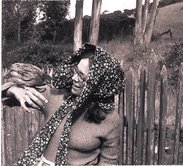CHICKENS ARE MORE LIKE PEOPLE THAN YOU THINK:
Story by Michaele (Mikie) Benedict***
 (Photo: Michaele with friend “Hulk.”)
(Photo: Michaele with friend “Hulk.”)
Jane Goodall had chimpanzees, Dian Fossey had gorrillas, Steve Irwin had crocodiles, and Suzanne and I, had, wellâ¦. chickens.
In 1972, we two city girls took over a ragged little flock in Purisima Canyon: Captain Crunch, the rooster, and his harem of white leghorns, Rhode Island reds, an Araucana and a few belligerent Silkies.
Since we (like the novice Jane with her chimps) had little experience with the animals, we were more interested in chicken behavior than with practical matters like eggs, though we did get a few eggs when the weather was good, and the girls werenât molting or trying to hatch chicks.
We kept a daily journal about our hen house. We bought laying mash from Feed and Fuel on Main Street in 50-pound bags. We raided the Alpha Beta dumpsters for limp lettuce.
The chickens taught us all sorts of things. A good rooster, we learned, is gallant, the official word for a desirable trait in the male. He will not only strut around and cock-a-doodle at first light. He will find tidbits for the hens and stand aside while they eat.
In fact, one problem with especially gallant roosters is starvation. Roosters use a special sound, a soft âbuk-bukâ?, which is used to call the henâs attention to something yummy. (A hen with chicks uses the same call: âHereâs a goodie, my dears.â?) A gallant rooster will fight off predatorsâoften to the death.
A gallant rooster, we discovered, would even teach a young hen how to make a nest, jumping into the nesting box, arranging the straw, sitting on nonexistent eggs and looking catatonic. Which is how the hens appeared when the urge to become mothers came over them. If one hen went broody, they all wanted to go broody.
To our horror, we discovered that hens know when an egg is not viable or may hatch out sooner or later than the rest of the clutch. They will get rid of the egg one way or another, usually by pushing it out of the nest so that it breaks.
Roosters will also fight rivals, which is why we had a problem when the hens started raising families. As soon as the scrawny adolescent youngsters began to practice crowing, they would be set upon by their father.
We also discovered that the proprietor of Georgeâs Toggery on Main Street in Half Moon Bay was happy to take young roosters off our hands, presumably for roasting. We delivered the quiet victims in burlap bags and tried not to think about it very much. At any rate, we neither had to slaughter those roosters ourselves nor watch them be hounded by the Alpha Male.
The childrenâs story about the hen that cried âThe sky is falling! The sky is falling!â? was surely written by someone who actually knew chickens. Chickens are, of course, easily alarmed and deserving of the name for cowardice. They can put out the most terrible racket over any threat, real or imaginedâ¦
BAWK! BAWK! BAWK!
â¦and, they actually have a vocalization sounding something like âAwkâ? to alert each other to anything flying overhead, hawk or airplane. Since chickens canât see in front of their beaks, they will comically turn their heads to watch the sky with one eye and then the other.
The pecking order is as unyielding as a catechism, and the chicken at the bottom not only gets pecked by every one more highly ranked, but also has to be the last to eat. A flock without a rooster will come under the protection of the dominant hen, who may even try to learn to crow.
In 1972, Feed and Fuel dispensed veterinary advice as well as baby chicks, straw, oyster shell and grain. When the flock came down with scaly leg mite, someone at Feed and Fuel advised mixing snuff and sulfur with Vaseline and applying it to the chickensâ legs. It wasnât easy to catch the girls, upend them and smear their legs with this vile stuff, but it did cure them.
Most of the girls had names: Shasta, Paloma, Bruna, and the Rhode Island Reds, Mao, Trostkina and Lenina. We ordered more chicks from a firm that guaranteed their gender (female, after Georgeâs Toggery closed), and they arrived by mail, a loud little yellow crowd in a box no larger than a shoebox.
Commercial operations calculate the ratio of chicken meat or eggs to the amount of feed given, and they usually slaughter the chickens after only a year or two. Our chickens mostly died of old age, however, and did so from the last ranking (most pecked) up.
My last chicken, which had once been the dominant hen, finally died when she was nine or ten years old. I found her down in the coop, stone cold with her feet in the air, just like a cartoon chicken. She might have died of natural causes, but I always thought she
died, because, being the last of the flock, she had nobody left to peck.
———————
***Michaele Benedictâs beloved daughter, Anna vanished from her Purisima Creek home in 1974. Please visit Michaele Benedictâs (searchingforanna.com website)â click here
